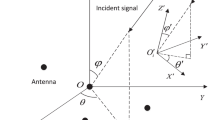Abstract
The problem of source number detection based on a distributed polarization-sensitive array (DPSA) is considered in this paper. We propose a DPSA to improve the matching coefficient that can be used to measure the eigenvalues. We theoretically prove that DPSA has a lower matching coefficient than the traditional uniform circular array (UCA) when the incident sources are uncorrelated, and we then obtain the eigenvalues by using the matching coefficient. Moreover, we discuss the change in eigenvalues under the assumption that the power of the signals is unequal. Numerical simulations show that the source detection probability of the DPSA is enhanced compared with the traditional UCA. Meanwhile, increasing the power of the stronger received signal improves the detection probability when the source power is unequal.







Similar content being viewed by others
Notes
This indicates that the electric and magnetic fields of the electromagnetic wave are in the plane perpendicular to the propagation direction.
For linearly transverse electromagnetic waves \(\gamma _k =0\), \(\eta _k=0\), or \(\eta _k=- \,180^\circ \); for circularly polarized waves, \(\gamma _k=45^\circ \) and \(\eta _k=\pm \, 90^\circ \), and the signal has a left or right hand circular polarization (LHCP or RHCP); see [18].
References
H. Akaike, A new look at the statistical model identification. IEEE Trans. Autom. Control 19, 716–723 (1974)
O.M. Bucci, T. Isernia, A.F. Morabito, Optimal synthesis of circularly symmetric shaped beams. IEEE Trans. Antennas Propag. 62, 1954–1964 (2014)
Q. Cheng, Y.B. Hua, Performance analysis of the MUSIC and Pencil-MUSIC algorithms for diversely polarized array. IEEE Trans. Signal Process. 32, 284–299 (1996)
W. Dong, M. Diao, L. Gao, L. Liu, A low-complexity DOA and polarization method of polarization-sensitive array. Sensors 17(5), 1170 (2017)
R. Goossens, H. Rogier, A hybrid UCA-RARE/Root-MUSIC approach for 2-D direction of arrival estimation in uniform circular arrays in the presence of mutual coupling. IEEE Trans. Antennas Propag. 55, 841–849 (2007)
M. Häge , M. Oispuu, DOA and polarization accuracy study for an imperfect dual-polarized antenna array, in European Signal Processing Conference (2011), pp. 599–603
M. Hajian, H. Nikookar, F. Der Zwan, Branch correlation measurements and analysis in an indoor Rayleigh fading channel for polarization diversity using a dual polarized patch antenna. IEEE Microwave Wirel. Compon. Lett. 15, 555–557 (2005)
E.J. Hannan, B.G. Quinn, The determination of the order of an autoregression. J. R. Stat. Soc. 41, 190–195 (1979)
Y. Han, Q. Fang, F. Yan, M. Jin, X. Qiao, Joint DOA and polarization estimation for unequal power sources based on reconstructed noise subspace. J. Syst. Eng. Electron. 27, 501–513 (2016)
K. Han, A. Nehorai, Improved source number detection and direction estimation with nested arrays and ULAs using jackknifing. IEEE Trans. Signal Process. 61, 6118–6128 (2013)
Z. He, A. Cichocke, S. Xie, K. Choi, Detecting the number of clusters in n-way probabilistic clustering. IEEE Trans. Pattern Anal. Mach. Intell. 32, 2006–2021 (2010)
J. Li, R.T. Compton, Angle and polarization estimation using ESPRIT with a polarization sensitive array. IEEE Trans. Antennas Propag. 39, 1376–1383 (1991)
B. Lindmark, S. Lundgren, J.R. Sanford, Dual-polarized array for signal-processing applications in wireless communications. IEEE Trans. Antennas Propag. 46, 758–763 (1998)
K. Louertani, R. Guinvarc’h, N. Ribiere-Tharaud, M. Helier, Study of the radiated polarization of an antenna array with circular geometry. Prog. Electromagn. Res. C 24, 173–183 (2011)
S. Miron, N.L. Bihan, J. Mars, Quaternion-MUSIC for vector-sensor. IEEE Trans. Signal Process. 54, 1218–1229 (2006)
D. Rahamim, J. Tabrikian, R. Shavit, Source localization using vector sensor array in a multipath environment. IEEE Trans. Signal Process. 52, 3096–3103 (2004)
M. Wax, I. Ziskind, Detection of the number of coherent signals by the MDL principle. IEEE Trans. Acoust. Speech Signal Process 37, 1190–1196 (1989)
K.T. Wong, M.D. Zoltowski, Closed-form direction finding and polarization estimation with arbitrarily spaced electromagnetic vector-sensors at unknown locations. IEEE Trans. Antennas Propag. 48, 671–681 (2000)
K.T. Wong, M.D. Zoltowski, Root-MUSIC-based direction-finding and polarization estimation using diversely polarized possibly collocated antennas. IEEE Trans. Antennas Wirel. Propag. 3, 129–132 (2004)
K.T. Wong, M.D. Zoltowski, Self-initiating MUSIC-based direction finding and polarization estimation in spatio-polarizational beamspace. Trans. Antennas Propag. 48, 1235–1245 (2000)
A. Zanella, M. Chiani, M.Z. Win, The effect of unequal power reception in cellular MIMO networks. Signal Process. 90, 1850–1860 (2010)
Acknowledgements
This work was supported in part by the National Science Foundation of China under Grant 61571149. The authors would like to thank the anonymous reviewers and the associate editor for their valuable comments and suggestions, which have greatly improved the quality of this paper.
Author information
Authors and Affiliations
Contributions
The main idea was proposed by Wen Dong. Lipeng Gao and Ming Diao performed the experiments and analyzed the simulation results. Wen Dong wrote the paper.
Corresponding author
Ethics declarations
Conflict of interest
The authors declare no conflict of interest. The founding sponsors had no role in the design of the study; in the collection, analyses, or interpretation of data; in the writing of the manuscript, and in the decision to publish the results.
Additional information
Publisher's Note
Springer Nature remains neutral with regard to jurisdictional claims in published maps and institutional affiliations.
Rights and permissions
About this article
Cite this article
Dong, W., Diao, M. The Resolving Power Analysis of a Distributed Polarization-Sensitive Array. Circuits Syst Signal Process 38, 4040–4055 (2019). https://doi.org/10.1007/s00034-019-01038-9
Received:
Revised:
Accepted:
Published:
Issue Date:
DOI: https://doi.org/10.1007/s00034-019-01038-9




